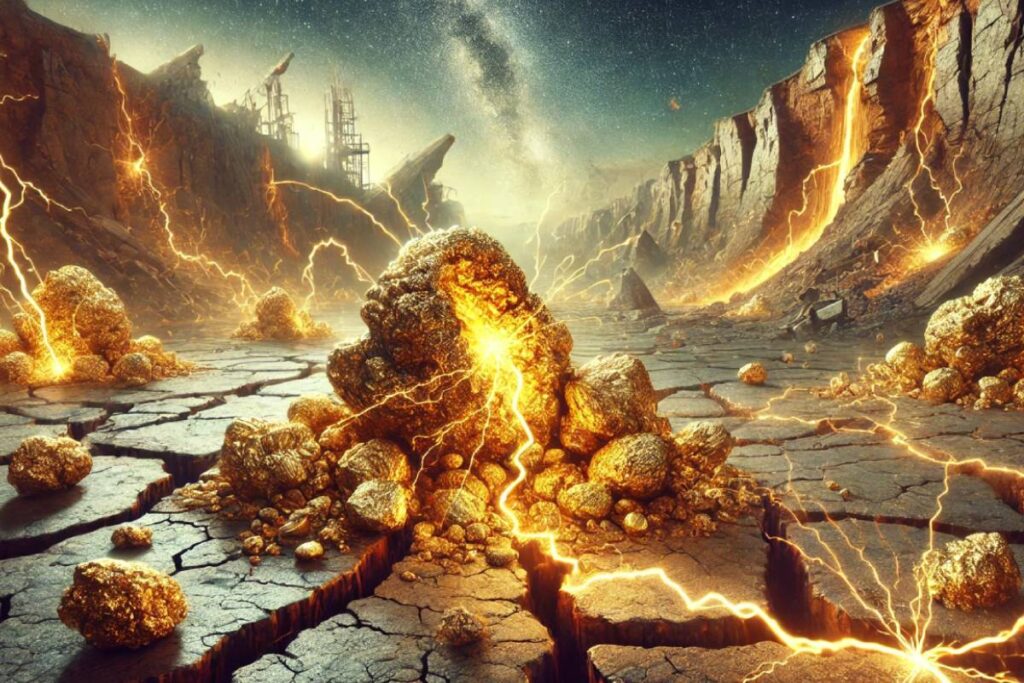The formation of giant gold nuggets has long fascinated geologists and treasure hunters alike. While gold deposits are generally understood to form through natural processes involving water and minerals deep beneath the Earth’s surface, a new and intriguing theory suggests that the secret behind these massive nuggets could lie in the electric sparks generated by earthquakes. Recent studies have proposed that the electrical activity associated with seismic activity may play a role in the creation of gold deposits, opening new avenues for understanding and potentially even locating gold formations. In this blog post, we will explore how electric sparks from earthquakes may be linked to giant gold nuggets, the science behind this phenomenon, and its implications for gold prospecting.
How Earthquakes Generate Electric Sparks
Earthquakes are known for their devastating power, but they may also generate electrical sparks as a byproduct of seismic activity. High-volume keywords: “earthquake electric sparks,” “earthquake-generated electricity,” “earthquake gold nugget formation.”
Piezoelectric Effect in Earthquakes
One possible explanation for the generation of electric sparks during earthquakes is the piezoelectric effect. Certain materials, such as quartz, produce an electric charge when they are subjected to mechanical stress, such as the immense pressure caused by tectonic shifts during an earthquake. As rocks containing these minerals fracture and grind against one another, the stress can cause bursts of electricity to be released.
Example: This electric charge may travel through fault lines, creating electrical discharges that affect the surrounding mineral-rich fluids, leading to chemical reactions that result in gold precipitation.
The Role of Electromagnetic Waves
Another aspect of this theory is that earthquakes can generate electromagnetic waves. These waves, in combination with electrical discharges, may trigger changes in underground fluids, causing metals like gold to come out of solution and form solid nuggets.
Example: During seismic activity, the combination of pressure, temperature, and electric currents could catalyze the transformation of dissolved gold into larger, concentrated formations.
How Electric Sparks Contribute to Gold Nugget Formation
The key question is how these electric sparks contribute to the formation of large gold nuggets. High-volume keywords: “gold nugget formation,” “seismic gold deposits,” “earthquake gold discovery.”
Precipitation of Gold from Mineral-Rich Fluids
Gold is often found in quartz veins or in solution within mineral-rich fluids. When these fluids are exposed to the right conditions—such as changes in temperature, pressure, or electrical charge—they can cause gold to precipitate out of the solution and crystallize. The electrical discharges generated by earthquakes may act as a catalyst for this precipitation process, effectively “zapping” the gold into solid form.
Example: In areas with a history of seismic activity, it is possible that large concentrations of gold were formed over time due to repeated electrical discharges associated with earthquakes.
Accelerating Nugget Growth
One theory suggests that the electric currents created by earthquakes could accelerate the process by which gold nuggets grow. Instead of taking thousands or millions of years to form, as is often the case with natural mineral deposits, the electric discharges could cause gold to accumulate rapidly into larger formations.
Example: In certain regions, this process might explain the presence of exceptionally large gold nuggets that seem to have formed in a relatively short geological time frame.
Implications for Gold Prospecting
If electric sparks from earthquakes do indeed play a role in gold nugget formation, it could have profound implications for modern gold prospecting. High-volume keywords: “gold prospecting techniques,” “earthquake gold discovery,” “seismic activity gold prospecting.”
Identifying Seismically Active Regions
Gold prospectors may begin to focus more heavily on regions with a history of seismic activity, particularly where gold has been found in the past. By studying fault lines and areas known for frequent earthquakes, geologists might be able to identify new locations where large gold deposits could be hidden underground.
Example: Regions such as California, which is seismically active and has a rich history of gold discoveries, could be key areas for future exploration using this approach.
The Role of Technology in Gold Detection
Advanced technology, such as electromagnetic sensing equipment, could be used to detect electrical discharges or other signs of gold formation during seismic events. This would enable prospectors to locate gold deposits more efficiently, potentially transforming the industry and leading to new discoveries.
Example: Using sensors that detect electromagnetic waves or piezoelectric effects might offer a new way to pinpoint gold-rich areas without traditional drilling or sampling techniques.
Conclusion
The idea that electric sparks from earthquakes could be linked to the formation of giant gold nuggets is an exciting and novel concept that brings together the fields of geology, physics, and gold prospecting. While more research is needed to fully understand this phenomenon, the potential for discovering new gold deposits in seismically active regions could open up new opportunities for prospectors and geologists alike. As technology advances, the ability to detect gold through electrical signals may transform the way we approach gold mining, making it more efficient and potentially leading to new discoveries.


